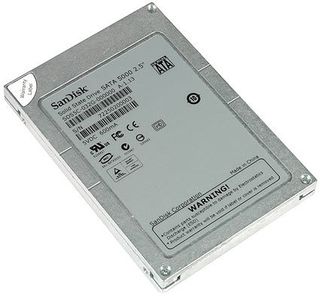Solid State Disk Drives Are Here
SanDisk SATA 5000 2.5"

The really good news first: At 68 MB/s, this is the fastest "hard drive" in a 2.5" form factor we've seen yet, and the 50 MB/s write performance isn't bad either. An access time of 0.1 ms practically no longer exists and is close to the limit of what most benchmark programs can track. The SSD 5000 doesn't have any DRAM cache, which conventional hard drives have, because the performance benefit would be little to zero. Hence, the interface bandwidth we measured equals the maximum data transfer rate with the SATA/150 interface. The performance under IOMeter varied a lot: On the one hand, the SSD 5000 flash SSD dominates the Webserver benchmark. For this test, it is 30 times faster than conventional hard drives. However, it is totally behind state-of-the-art 2.5" hard drives as measured by fileserver, database and workstation benchmarks. This is the case because NAND flash products offer quick read access time, but write access takes considerably longer. These three benchmarks take many random write speeds into account, which lowers the benchmark results.
While SanDisk points out that the drive is much more energy efficient than any hard drive, it fails to reach the low power consumption results we saw in our review of Samsung's flash SSD in September 2006. However, the relative low power-consumption performance isn't because of the flash technology, but is due to the interface. The new SanDisk drive uses a Serial ATA/150 interface that consumes 0.5 W when idle, which is 10 times higher than the power consumption of the Samsung device, which consumes 0.05 W when idle.
Indeed, serial interface power requirements are relatively high in general, regardless of whether you are comparing Serial ATA vs. UltraATA or PCI Express vs. PCI/PCI-X. However, the comparison should be made between the SanDisk drive and conventional hard drives. While the SATA interface offered the best energy-consumption performance as the flash SSD never went below 0.5 W when idle, this is still well below the 0.7+ W we measured for mechanical 2.5" hard drives. Looking at the results of Samsung's 32 GB SDD (with UltraATA/66), it's very obvious that flash memory by itself is more energy efficient. However, there is still room for improvement. Still, drives with 7,200 RPM, which we should compare to flash SSDs due to their target customers (enthusiasts and workstations), require at least double the idle power. Activity power, however, maxed out at 1.0 W. Compared to 2.4 W to 4.6 W for other 2.5" drives, this is a huge difference.
We already mentioned the aluminum case, which is the main reason for the SDD 5000's 94-g weight. Compared to other 2.5" hard drives that weigh 95 g to 105 g, this still is an excellent result, and the metal case provides ideal protection for the memory chips. However, the weight of the Samsung prototype is roughly half that of the SDD 5000.


Stay on the Cutting Edge
Join the experts who read Tom's Hardware for the inside track on enthusiast PC tech news — and have for over 25 years. We'll send breaking news and in-depth reviews of CPUs, GPUs, AI, maker hardware and more straight to your inbox.
Current page: SanDisk SATA 5000 2.5"
Prev Page Flash Vs. Flash Next Page RAID With Flash Hard DrivesMost Popular

